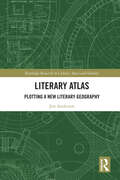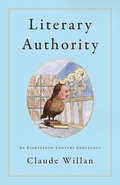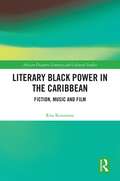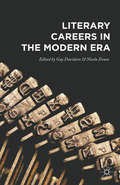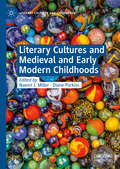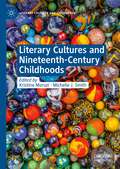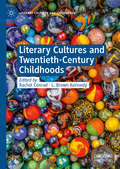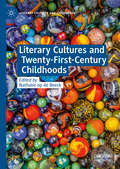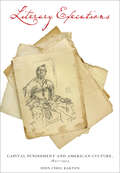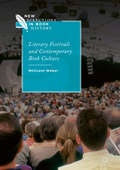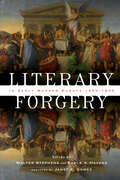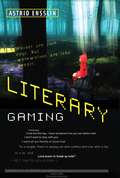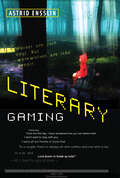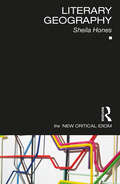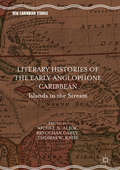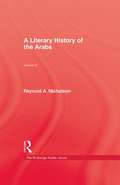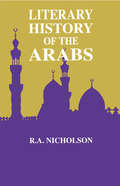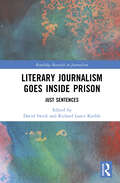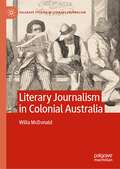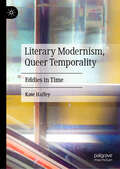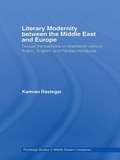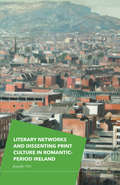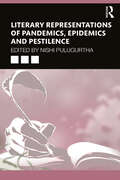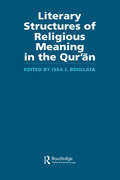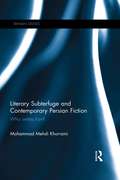- Table View
- List View
Literary Atlas: Plotting a New Literary Geography (Routledge Research in Culture, Space and Identity)
by Jon AndersonThis book documents a new approach to literary geographies based around the Literary Atlas of Wales. It introduces an innovative "plotted" approach which empowers reading, creates connections to localities, histories, and communities, and inspires interest in literature and geography.It showcases how literary geographies can be mobilized through the plotted approach to reading. Through documenting the Literary Atlas of Wales project, this book outlines how the plotted approach was used to engage with English-language novels set in Wales. It argues that the future of this interdisciplinary subject area should be premised upon nurturing instability, turbulence, and experimentation in order to produce new insights which can change the way we understand the relations not only between literature and place but also between other modern categories, including academic disciplines.This book will be of interest to all readers of literature, human geography, mapping, heritage studies, and tourism. It will be beneficial to those interested in the domains of cartography, creative humanities, cultural sociology, human geography, literary studies, and print cultures.
Literary Authority: An Eighteenth-Century Genealogy
by Claude WillanThis book is the cultural history of an idea which now seems so self-evident as barely to be worth stating: through writing imaginative literature, an author can accrue significant and lasting economic and cultural power. We take for granted, now, that authority dwells in literature and in being its author. This state of affairs was not naturally occurring, but deliberately invented. This book tells the story of that invention. The story's central figures are Alexander Pope and Samuel Johnson. But its narrative begins in the 1680s, with the last gasp of the bond linking literary to political authority. While Jacobite poets celebrated (and mourned) the Stuart dynasty, Whig writers traced the philosophical and aesthetic consequences of the accession of William of Orange. Both groups left behind sets of literary devices ready-made to confer and validate authority. Claude Willan challenges the continued reign of the "Scriblerian" model of the period and shows how that reign was engineered. In so doing he historicizes the relationship between "good" and "bad" writing, and suggests how we might think about literature and beauty had Pope and Johnson not taken literary authority for themselves. What might literature have looked like, and what could we use it for, he provocatively asks.
Literary Black Power in the Caribbean: Fiction, Music and Film (African Diaspora Literary and Cultural Studies)
by Rita KeresztesiLiterary Black Power in the Caribbean focuses on the Black Power movement in the anglophone Caribbean as represented and critically debated in literary texts, music and film. This volume is groundbreaking in its focus on the creative arts and artists in their evaluations of, and insights on, the relevance of the Black Power message across the region. The author takes a cultural studies approach to bring together the political with the aesthetic, enriching an already fertile debate on the era and the subject of Black Power in the Caribbean region. The chapters discuss various aspects of Black Power in the Caribbean: on the pages of journals and magazines, at contemporary conferences that radicalized academia to join forces with communities, in fiction and essays by writers and intellectuals, in calypso and reggae music, and in the first films produced in the Caribbean. Produced at the 50th anniversary of the 1970 Black Power Revolution in Port of Spain, Trinidad, this timely book will be of interest to students and academics focusing on Black Power, Caribbean literary and cultural studies, African diaspora, and Global South radical political and cultural theory.
Literary Careers in the Modern Era
by Guy Davidson Nicola EvansThis is the first study of the shape and diversity of the literary career in the 20th and 21st centuries. Bringing together essays on a wide range of authors from Australia, Canada, the United States and the United Kingdom, the book investigates how literary careers are made and unmade, and how norms of authorship are shifting in the digital era.
Literary Cultures and Medieval and Early Modern Childhoods (Literary Cultures and Childhoods)
by Naomi J. Miller Diane PurkissBuilding on recent critical work, this volume offers a comprehensive consideration of the nature and forms of medieval and early modern childhoods, viewed through literary cultures. Its five groups of thematic essays range across a spectrum of disciplines, periods, and locations, from cultural anthropology and folklore to performance studies and the history of science, and from Anglo-Saxon burial sites to colonial America. Contributors include several renowned writers for children. The opening group of essays, Educating Children, explores what is perhaps the most powerful social engine for the shaping of a child. Performing Childhood addresses children at work and the role of play in the development of social imitation and learning. Literatures of Childhood examines texts written for children that reveal alternative conceptions of parent/child relations. In Legacies of Childhood, expressions of grief at the loss of a child offer a window into the family’s conceptions and values. Finally, Fictionalizing Literary Cultures for Children considers the real, material child versus the fantasy of the child as a subject.
Literary Cultures and Nineteenth-Century Childhoods (Literary Cultures and Childhoods)
by Kristine Moruzi Michelle J. SmithLiterary Cultures and Nineteenth-Century Childhoods explores the construction of the child and the development of texts for children in the nineteenth century through the application of fresh theoretical approaches and attention to aspects of literary childhoods that have only recently begun to be illuminated. This scope enables examination of the child in canonical nineteenth-century novels by Charles Dickens, Elizabeth Gaskell, Charlotte Bronte, and Thomas Hardy alongside well-known fiction intended for young readers by George MacDonald, Christabel Coleridge, and Kate Greenaway. The century was also distinctive for the rise of the children’s magazine, and this book broadens the definition of literary cultures to include magazines produced both by, and for, young people. The volume examines how the child and family are conceptualised, how children are positioned as readers in genres including the domestic novel, school story, Robinsonade, and fantasy fiction, how literary childhoods are written and politicised, and how childhood intersects with perceptions of animals and the natural environment. The range of chapters in this collection and the texts they consider demonstrates the variability and fluidity of literary cultures and nineteenth-century childhoods.
Literary Cultures and Twentieth-Century Childhoods (Literary Cultures and Childhoods)
by Rachel Conrad L. Brown KennedyThis collection of essays offers innovative methodological and disciplinary approaches to the intersection of Anglophone literary cultures with children and childhoods across the twentieth century. In two acts of re-centering, the volume focuses both on the multiplicity of childhoods and literary cultures and on child agency. Looking at classic texts for young audiences and at less widely-read and unpublished material (across genres including poetry, fiction, historical fiction or biography, picturebooks, and children’s television), essays foreground the representation of child voices and subjectivities within texts, explore challenges to received notions of childhood, and emphasize the role of child-oriented texts in larger cultural and political projects. Chapters frame themes of spectacle, self, and specularity across the twentieth-century; question tropes of childhood; explore identity and displacement in narrating history and culture; and elevate children as makers of literary culture. A major intent of the volume is to approach literary culture not just as produced by adults for consumption by children but also as co-created by young people through their actions as speakers, artists, readers, and writers.
Literary Cultures and Twenty-First-Century Childhoods (Literary Cultures and Childhoods)
by Nathalie op de BeeckIn the early decades of the twenty-first century, we are grappling with the legaciesof past centuries and their cascading effects upon children and all people. Werealize anew how imperialism, globalization, industrialization, and revolutioncontinue to reshape our world and that of new generations. At a volatile moment,this collection asks how twenty-first century literature and related mediarepresent and shape the contemporary child, childhood, and youth.Because literary representations construct ideal childhoods as well as model therights, privileges, and respect afforded to actual young people, this collectionsurveys examples from popular culture and from scholarly practice. Chaptersinvestigate the human rights of children in literature and international policy; thepotential subjective agency and power of the child; the role models proposed foryoung people; the diverse identities children embody and encounter; and theenvironmental well-being of future human and nonhuman generations.As a snapshot of our developing historical moment, this collection identifiesemergent trends, considers theories and critiques of childhood and literature,and observes how new technologies and paradigms are destabilizing pastconventions of storytelling and lived experience.
Literary Executions: Capital Punishment and American Culture, 1820–1925
by John Cyril Barton“Rich with historical detail . . . examines the figure and theme of the death penalty in imaginative literature from Cooper to Dreiser.” —Gregg Crane, Professor of English Language and Literature, University of MichiganDrawing from legal and extralegal discourse but focusing on imaginative literature, Literary Executions examines representations of, responses to, and arguments for and against the death penalty in the United States over the long nineteenth century. John Cyril Barton creates a generative dialogue between artistic relics and legal history. He looks to novels, short stories, poems, and creative nonfiction as well as legislative reports, trial transcripts, legal documents, newspaper and journal articles, treatises, and popular books (like The Record of Crimes, A Defence of Capital Punishment, and The Gallows, the Prison, and the Poor House), all of which were part of the debate over the death penalty.Barton focuses on several canonical figures—James Fenimore Cooper, Nathaniel Hawthorne, Lydia Maria Child, Walt Whitman, Herman Melville, and Theodore Dreiser—and offers new readings of their work in light of the death penalty controversy. Barton also gives close attention to a host of then-popular-but-now-forgotten writers—particularly John Neal, Slidell MacKenzie, William Gilmore Simms, Sylvester Judd, and George Lippard—whose work helped shape or was shaped by the influential anti-gallows movement.By engaging the politics and poetics of capital punishment, Literary Executions contends that the movement to abolish the death penalty in the United States should be seen as an important part of the context that brought about the flowering of the American Renaissance during the antebellum period and that influenced literature later in the nineteenth and early twentieth centuries
Literary Festivals and Contemporary Book Culture (New Directions in Book History)
by Millicent WeberThere has been a proliferation of literary festivals in recent decades, with more than 450 held annually in the UK and Australia alone. These festivals operate as tastemakers shaping cultural consumption; as educational and policy projects; as instantiations, representations, and celebrations of literary communities; and as cultural products in their own right. As such they strongly influence how literary culture is produced, circulates and is experienced by readers in the twenty-first century. This book explores how audiences engage with literary festivals, and analyses these festivals’ relationship to local and digital literary communities, to the creative industries focus of contemporary cultural policy, and to the broader literary field. The relationship between literary festivals and these configuring forces is illustrated with in-depth case studies of the Edinburgh International Book Festival, the Port Eliot Festival, the Melbourne Writers Festival, the Emerging Writers’ Festival, and the Clunes Booktown Festival. Building on interviews with audiences and staff, contextualised by a large-scale online survey of literary festival audiences from around the world, this book investigates these festivals’ social, cultural, commercial, and political operation. In doing so, this book critically orients scholarly investigation of literary festivals with respect to the complex and contested terrain of contemporary book culture.
Literary Forgery in Early Modern Europe, 1450–1800
by Janet E Gomez“The essays gathered in this volume demonstrate that studying early modern European literary forgeries is a fascinating cultural adventure” (Lina Bolzoni author of The Gallery of Memory).This comprehensive study of literary and historiographical forgery goes well beyond questions of authorship. It spotlights the imaginative vitality of forgery and its sinister impact on genuine scholarship. This volume demonstrates that early modern forgery was a literary tradition in its own right, with distinctive connections to politics, Greek and Roman classics, religion, philosophy, and modern literature. The early modern explosion in forgery of all kinds—particularly in the fields of literary and archaeological falsification—demonstrates a dramatic shift in attitudes toward historical evidence and in the relation of texts to contemporary society. The authors capture the impact of this evolution within many cultural transformations, including the rise of print, changing tastes and fortunes of the literary marketplace, and the Protestant and Catholic Reformations.The thirteen essays draw on Johns Hopkins University’s Bibliotheca Fictiva, the world’s premier research collection dedicated exclusively to the subject of literary forgery. It consists of several thousand rare books and unique manuscript materials from the early modern period and beyond.Contributors: Frederic Clark, James Coleman, Richard Cooper, Arthur Freeman, Anthony Grafton, A. Katie Harris, Earle A. Havens, Jack Lynch, Shana D. O’Connell, Ingrid Rowland, Walter Stephens, Elly Truitt, Kate Tunstall
Literary Gaming
by Astrid EnsslinIn this book, Astrid Ensslin examines literary videogames -- hybrid digital artifacts that have elements of both games and literature, combining the ludic and the literary. These works can be considered verbal art in the broadest sense (in that language plays a significant part in their aesthetic appeal); they draw on game mechanics; and they are digital-born, dependent on a digital medium (unlike, for example, conventional books read on e-readers). They employ narrative, dramatic, and poetic techniques in order to explore the affordances and limitations of ludic structures and processes, and they are designed to make players reflect on conventional game characteristics. Ensslin approaches these hybrid works as a new form of experimental literary art that requires novel ways of playing and reading. She proposes a systematic method for analyzing literary-ludic (L-L) texts that takes into account the analytic concerns of both literary stylistics and ludology.After establishing the theoretical underpinnings of her proposal, Ensslin introduces the L-L spectrum as an analytical framework for literary games. Based on the phenomenological distinction between deep and hyper attention, the L-L spectrum charts a work's relative emphases on reading and gameplay. Ensslin applies this analytical toolkit to close readings of selected works, moving from the predominantly literary to the primarily ludic, from online hypermedia fiction to Flash fiction to interactive fiction to poetry games to a highly designed literary "auteur" game. Finally, she considers her innovative analytical methodology in the context of contemporary ludology, media studies, and literary discourse analysis.
Literary Gaming (The\mit Press Ser.)
by Astrid EnsslinA new analytical framework for understanding literary videogames, the literary-ludic spectrum, illustrated by close readings of selected works.In this book, Astrid Ensslin examines literary videogames—hybrid digital artifacts that have elements of both games and literature, combining the ludic and the literary. These works can be considered verbal art in the broadest sense (in that language plays a significant part in their aesthetic appeal); they draw on game mechanics; and they are digital-born, dependent on a digital medium (unlike, for example, conventional books read on e-readers). They employ narrative, dramatic, and poetic techniques in order to explore the affordances and limitations of ludic structures and processes, and they are designed to make players reflect on conventional game characteristics. Ensslin approaches these hybrid works as a new form of experimental literary art that requires novel ways of playing and reading. She proposes a systematic method for analyzing literary-ludic (L-L) texts that takes into account the analytic concerns of both literary stylistics and ludology.After establishing the theoretical underpinnings of her proposal, Ensslin introduces the L-L spectrum as an analytical framework for literary games. Based on the phenomenological distinction between deep and hyper attention, the L-L spectrum charts a work's relative emphases on reading and gameplay. Ensslin applies this analytical toolkit to close readings of selected works, moving from the predominantly literary to the primarily ludic, from online hypermedia fiction to Flash fiction to interactive fiction to poetry games to a highly designed literary “auteur” game. Finally, she considers her innovative analytical methodology in the context of contemporary ludology, media studies, and literary discourse analysis.
Literary Geography (The New Critical Idiom)
by Sheila HonesLiterary Geography provides an introduction to work in the field, making the interdiscipline accessible and visible to students and academics working in literary studies and human geography, as well as related fields such as the geohumanities, place writing and geopoetics. Emphasising the long tradition of work with literary texts in human geography, this volume: provides an overview of literary geography as an interdiscipline, which combines aims and methods from human geography and literary studies explains how and why literary geography differs from spatially-oriented critical approaches in literary studies reviews geographical work with literary texts from the late 19th century to the present day includes a glossary of key terms and concepts employed in contemporary literary geography. Accessible and clear, this comprehensive overview is an essential guide for anyone interested in learning more about the history, current activity and future of work in the interdiscipline of literary geography.
Literary Histories of the Early Anglophone Caribbean: Islands In The Stream (New Caribbean Studies)
by Brycchan Carey Nicole N. Aljoe Thomas W. KriseThe Caribbean has traditionally been understood as a region that did not develop a significant ‘native’ literary culture until the postcolonial period. Indeed, most literary histories of the Caribbean begin with the texts associated with the independence movements of the early twentieth century. However, as recent research has shown, although the printing press did not arrive in the Caribbean until 1718, the roots of Caribbean literary history predate its arrival. This collection contributes to this research by filling a significant gap in literary and historical knowledge with the first collection of essays specifically focused on the literatures of the early Caribbean before 1850.
Literary History Of The Arabs
by NicholsonFirst Published in 1998. Routledge is an imprint of Taylor & Francis, an informa company.
Literary History Of The Arabs
by Reynold A. NicholsonFirst published in 2004. Routledge is an imprint of Taylor & Francis, an informa company.
Literary Journalism Goes Inside Prison: Just Sentences (Routledge Research in Journalism)
by Richard Lance Keeble David SwickLiterary Journalism Goes Inside Prison: Just Sentences opens up a new exploration of literary journalism – immersive, long-form journalism so beautifully written that it can stand as literature – in the first anthology to examine literary journalism and prison. In this book, a wide range of compelling subjects are considered. These include Nelson Mandela and other prisoners of apartheid; the made-in-prison podcast Ear Hustle; women’s experiences of life behind bars; Behrouz Boochani’s 2018 bestseller No Friend but the Mountains; George Orwell’s artful writing on incarceration; Pete Earley’s immersion into the largest prison in the United States, The Hot House; Arthur Koestler and the Spanish Civil War; Ted Conover’s year as a prison guard in Newjack: Guarding Sing Sing and (most originally) Bruce Springsteen’s execution narrative Nebraska. This volume will benefit anyone who writes, studies or teaches any form of narrative nonfiction. Eleven international scholars articulate what makes the work they are analysing so exceptional. At the same time, they offer insights on a diverse range of vital topics. These include journalism ethics, journalism and trauma, media history, cultural studies, criminology and social justice.
Literary Journalism in Colonial Australia (Palgrave Studies in Literary Journalism)
by Willa McDonaldThis book traces the beginnings of literary (narrative) journalism in Australia. It contributes to evolving international definitions of the form, while providing a glimpse into Australia’s early press history and development as a nation. The book comprises two parts. The first examines the forerunners of literary journalism before and during the establishment of a free press, including the letters, diaries and journals of the early colonists, as well as sketches published in the first magazines and newspapers. The book asks if these were “reporting” when there was no thriving press until well into the 19th century -- many were written by women and convicts whose voices otherwise went unheard. The second part examines the first expressions of literary journalism in forms more recognisable today, covering topics as varied as homelessness in Melbourne, the Queensland trade in Pacific Islander labour, and Australia’s involvement in overseas wars, particularly the Boer War. The resulting cultural history reveals important milestones in the development of Australia’s press and literature, while demonstrating the concerns unveiled in colonial literary journalism still resonate in Australia in the 21st century.
Literary Modernism, Queer Temporality: Eddies in Time
by Kate HaffeyThis book explores the intersection between the recent work on queer temporality and the experiments of literary modernism. Kate Haffey argues that queer theory’s recent work on time owes a debt to modernist authors who developed new ways of representing temporality in their texts. By reading a series of early twentieth-century literary texts from modernists like Woolf, Eliot, Faulkner, and Stein alongside contemporary authors, this book examines the way in which modernist writers challenged narrative conventions of time in ways that both illuminate and foreshadow current scholarship on queer temporality. In her analyses of contemporary novelists and critics Michael Cunningham, Jeanette Winterson, Angela Carter, and Eve Sedgwick, Haffey also shows that these modernist temporalities have been reconfigured by contemporary authors to develop new approaches to futurity.
Literary Modernity Between the Middle East and Europe: Textual Transactions in 19th Century Arabic, English and Persian Literatures (Routledge Studies in Middle Eastern Literatures)
by Kamran RastegarProviding a broad ranging and unique comparative study of the development of English, Persian and Arabic literature, this book looks at their interrelations with specific reference to modernity, nationalism and social value. It gives a strong theoretical underpinning to the development of Middle Eastern literature in the modern period.
Literary Networks and Dissenting Print Culture in Romantic-Period Ireland
by Jennifer OrrLiterary Networks and Dissenting Irish Print Culture examines the origins of Irish labouring-class poetry produced in the liminal space of revolutionary Ulster (1790-1815), where religious dissent fostered a unique and distinctive cultural identity.
Literary Representations of Pandemics, Epidemics and Pestilence
by Nishi PulugurthaDisease, pestilence and contagion have been an integral component of human lives and stories. This book explores the articulations and representations of the vulnerability of life or the trauma of death in literature about epidemics both from India and around the world. This book critically engages with stories and narratives that have dealt with pandemics or epidemics in the past and in contemporary times to see how these texts present human life coming to terms with upheaval, fear and uncertainty. Set in various places and times, the literature examined in this book explores the themes of human suffering and resilience, inequality, corruption, the ruin of civilizations and the rituals of grief and remembrance. The chapters in this volume cover a wide spatio-temporal trajectory analysing the writings of Fakir Mohan Senapati and Suryakant Tripathi Nirala, Jack London, Albert Camus, Margaret Atwood, Sarat Chand, Pandita Ramabai and Christina Sweeney-Baird, among others. It gives readers a glimpse into both grounded and fantastical realities where disease and death clash with human psychology and where philosophy, politics and social values are critiqued and problematized. This book will be of interest to students of English literature, social science, gender studies, cultural studies, psychology, society, politics and philosophy. General readers too will find this exciting as it covers authors from across the world.
Literary Structures of Religious Meaning in the Qu'ran (Routledge Studies in the Qur'an)
by Issa J BoullataThis volume studies how the literary elements in the Qur'an function in conveying its religious message effectively. It is divided into three parts. Part one includes studies of the whole Qur'an or large segments of it belonging to one historical period of its revelation; these studies concentrate on the analysis of its language, its style, its structural composition, its aesthetic characteristics, its rhetorical devices, its imagery, and the impact of these elements and their significance. Part two includes studies on individual suras of the Qur'an, each of which focuses on the sura's literary elements and how they produce meaning; each also explores the structure of this meaning and the coherence of its effect. Part three includes studies on Muslim appreciations of the literary aspects of the Qur'an in past generations and shows how modern linguistic, semantic, semiotic, and literary scholarship can add to their contributions.
Literary Subterfuge and Contemporary Persian Fiction: Who Writes Iran? (Iranian Studies)
by Mohammad Mehdi KhorramiThe main focus of Literary Subterfuge and Contemporary Persian Fiction is to identify components and elements which define Persian modernist fiction, placing an emphasis on literary concepts and devices which provide the dynamics of the evolutionary trajectory of this modernism. The question of ‘who writes Iran’ refers to a contested area which goes beyond the discipline of literary criticism. Non-literary discourses have made every effort to impose their "committed" readings on literary texts; they have even managed to exert influence on the process of literary creation. In this process, inevitably, many works, or segments of them, and many concepts which do not lend themselves to such readings have been ignored; at the same time, many of them have been appropriated by these discourses. Yet components and elements of Persian literary tradition have persistently engaged in this discursive confrontation, mainly by insisting on literature’s relative autonomy, so that at least concepts such as conformity and subterfuge, essential in terms of defining modern and modernist Persian fiction, could be defined in a literary manner. Proffering an alternative in terms of literary historiography; this book supports a methodological approach that considers literary narratives which occur in the margins of dominant discourses, and indeed promote non-discursivity, as the main writers of Persian modernist fiction. It is an essential resource for scholars and researchers interested in Persian and comparative literature, as well as Middle Eastern Studies more broadly.
